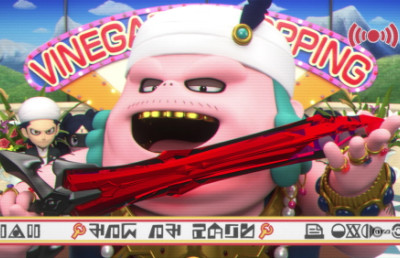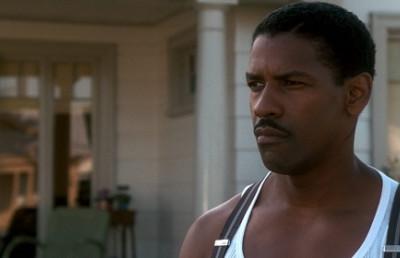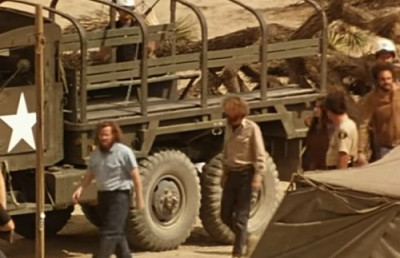Descriptive Audio: Direct Address in Banksy’s Exit Through the Gift Shop and Werner Herzog’s Little Dieter Needs to Fly
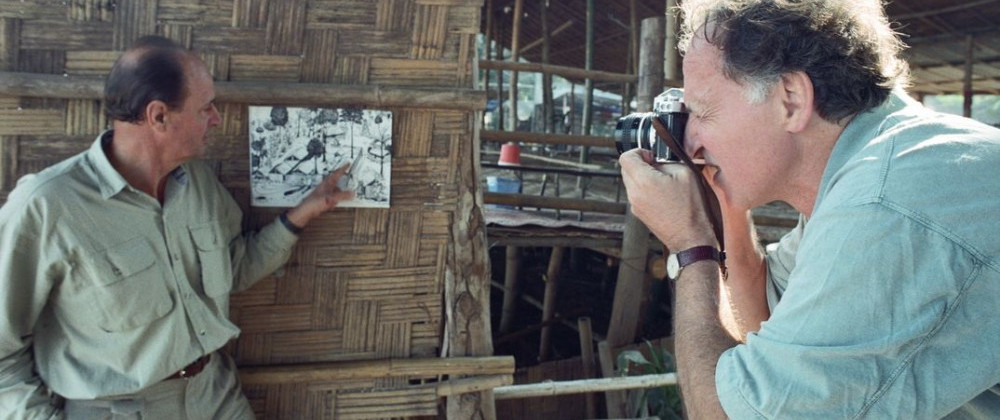
We have not seen any cinema yet. We have only seen 105 years of illustrated text.
—Peter Greenaway
As David Bordwell points out, the distinction screenplay gurus commonly make between “showing” and “telling” has its origins in ancient Greece, though in contrast with contemporary screenwriting manuals, “Aristotle did not, so far as I can tell, urge… dramatists to avoid having characters report offstage action.” So pervasive is the bias privileging showing above telling, which Bordwell traces back to early modernist writers like Joseph Conrad and Henry James (“a failed playwright”), that it even informs how we think about documentaries. Consider, for instance, Jan-Christopher Horak’s description of classical wildlife films, in which he extols the visible: “Such images were perceived as an expansion of human vision, a means of entering into a world that was invisible to the human eye” (459). Needless to say, the BBC wouldn’t air (and no one would tune in for) a nature documentary where the animals were just barely visible on the horizon, no matter how learned David Attenborough’s commentary happened to be, whereas Winged Migration (Jacques Perrin, Jacques Cluzaud, and Michel Debats, 2001)—which largely does without such commentary—was a modest hit in North American art houses (see “Winged Migration”).
That said, direct address in the form of printed titles, voice-over commentary, and talking head interviews is still pervasive in all types of documentaries, from reality TV shows about the rescue of abused animals to some of the most critically acclaimed feature documentaries of the past thirty years, including The Thin Blue Line (Errol Morris, 1988), Roger & Me (Michael Moore, 1989), Hoop Dreams (Steve James, 1994), Capturing the Friedmans (Andrew Jarecki, 2003), My Winnipeg (Guy Maddin, 2007), and Searching for Sugar Man (Malik Bendjelloul, 2012). Therefore, rather than dismissing such techniques tout court as evidence of lazy, manipulative filmmaking and the audience’s inability to recognize it, 1 we might ask: how do these devices enrich the experience of watching particular movies? In a more classical documentary like Banksy’s Exit Through the Gift Shop (2010), direct address makes the film comprehensible as a narrative by unifying large-scale segments and individual sequences, as well as arousing the viewer’s curiosity and guiding one’s emotions. On the other hand, though direct address still fulfills these traditional functions in Werner Herzog’s Little Dieter Needs to Fly (1997), the lack of a precise fit between Dieter Dengler’s oral testimony and the images illustrating his words self-reflexively foregrounds the fact that the viewer is always at two removes from Dengler’s experiences—that the movie is ultimately a representation of a representation. 2 However, rather than weakening the viewer’s emotional involvement, this self-reflexivity allows one to engage with the story in a different way. By examining the functions of direct address in these two films, I hope to demonstrate how filmmakers have exploited such techniques in order to enhance the telling of a story rather than merely using it as a crutch.
Daub and Dauber
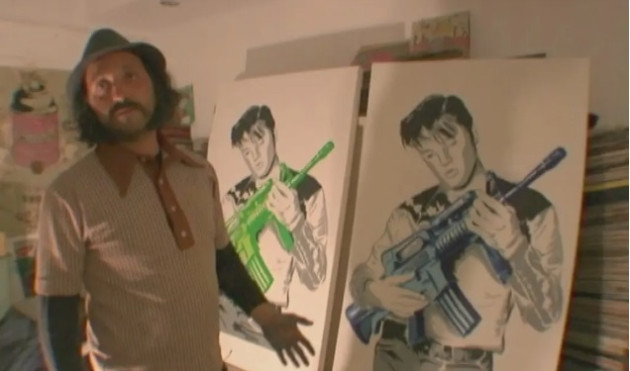
There isn’t a single sequence in Exit Through the Gift Shop that doesn’t employ some form of direct address and the overwhelming majority feature more than one. In addition to Rhys Ifans’ voice-over commentary and the talking head interviews which unify, and inflect the significance of, the footage shot by the film’s subject, Thierry Guetta (aka Mr. Brainwash), superimposed titles identify the people onscreen and give the dates when certain events occurred. What’s more, Guetta can often be heard in his own footage asking questions from behind the camera, and when Banksy sends a crew to document the preparations for Guetta’s first one-man art exhibition, Life Is Beautiful, Guetta and his staff frequently address the camera directly, as when Guetta proudly shows off a screen printed image he had made of Elvis Presley in which the singer’s guitar has been replaced with a children’s toy rifle (“This piece called ‘Don’t Be Cruel’”). As well as aiding comprehension, such devices stimulate the viewer’s curiosity and help to cultivate a dryly amused tone, and the movie would be considerably less entertaining without them.
Although it’s sometimes difficult to say precisely where one sequence ends and the next begins, the following segmentation should provide a rough idea of the film’s formal organization:
1. Opening credits; images of various street artists and their work
2. “Where’s the film?”
3. Thierry Guetta (Los Angeles, 1999)
4. The video camera
5. Guetta’s cousin, Space Invader (France, 1999)
6. The underground world of street art
7. Taping street artists in Los Angeles
8. Guetta meets Shepard Fairey
9. A street art documentary (2002-2003)
10. The mysterious Banksy; Guetta continues taping
11. The truth about Guetta’s documentary
12. Guetta’s childhood trauma and the origins of his obsession with taping
13. Banksy’s West Bank stunt and rising notoriety (2005)
14. Guetta meets Banksy
15. Taping in London
16. Back to Los Angeles; Guetta’s first sticker
17. Banksy arrives in Los Angeles; the Disneyland stunt
18. Media coverage of Banksy’s exhibition Barely Legal (2006)
19. The art market finds street art
20. Guetta starts editing his footage
21. LIFE REMOTE CONTROL: THE MOVIE (6 months later)
22. Mr. Brainwash
23. Guetta’s team and creative process (another 6 months later)
24. Finding a venue and hiring more staff
25. Guetta injures himself
26. Banksy sends help
27. Guetta hypes the show
28. The value of Guetta’s art
29. Opening day for Life Is Beautiful (June 18, 2008)
30. The crew takes over preparations
31. The doors open; success
32. The aftermath
33. The moral of the story
34. Epilogue
C. End credits
These thirty-four segments can be grouped into three large-scale segments—what Kristin Thompson would term a set-up, a development, and a climax (28-29). The set-up (segments 1-12) introduces Guetta, a Los Angeles-based vintage clothing retailer and unabashed bullshit artist who recorded every moment of his waking life on video. In 1999, while on holiday in his native France, Guetta discovered that his cousin was the celebrated street artist known as Space Invader, and began taping his work as well as that of other street artists, including the American Shepard Fairey—ostensibly with the intention of making a documentary about street art. The set-up ends with Guetta forming a specific goal—namely, to get the elusive British artist Banksy on tape—and the revelation that his documentary was merely a pretext to satisfy his twin obsessions with taping and celebrity. The development (segments 13-22) traces Banksy’s rising fame in the art world and the unlikely bromance that develops between him and Guetta. Eventually, Banksy takes possession of Guetta’s footage, and to get him out of the way while he edits it into this movie, Banksy suggests Guetta go back to Los Angeles and put on a small art exhibition of his own. The development ends with Guetta reinventing himself as a street artist and adopting the pseudonym Mr. Brainwash (or MBW for short). In the climax (segments 23-31), Guetta applies the skills he learned in the used clothing business to make the opening of Life Is Beautiful a major cultural event, despite the complete lack of originality in his work. The film ends with a short epilogue (segments 32-34), in which Banksy ponders what the moral of the story might be, or if it even has one, and printed titles describe what happened to the major participants after Guetta’s opening.
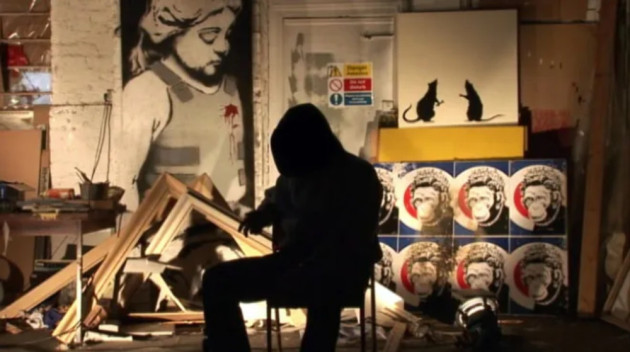
The most obvious and fundamental function of direct address is to make the film comprehensible as a narrative, with the voice-over commentary and talking head interviews unifying both large-scale segments and individual sequences. The credit sequence (segment 1) consists of a series of temporally and spatially discontinuous images of anonymous street artists tagging various sites (mostly at night) and running away from the police as Richard Hawley’s romantic rock anthem “Tonight the Streets Are Ours” plays on the soundtrack, priming the viewer for a celebratory documentary about the outlaw world of street art. (Most spectators will be aware going into the movie that Banksy himself is a noted street artist.) In the next sequence, however, when an offscreen interviewer asks Banksy where the film is, he replies, “Well, the film is, uh, the story of what happened when this guy tried to make a documentary about me. But he was actually a lot more interesting than I am, so now the documentary is kind of about him,” prompting the viewer to radically revise their expectations. The interviewer’s next question, “So who is this guy?” is answered by a cut to a low angle shot of Guetta fogging the lens of the camera with his breath and wiping it with a cloth, his face coming into clear focus as Ifans says in voice-over, “That guy was Thierry Guetta”—at once establishing the identity of the story’s protagonist and subtly foreshadowing the importance his camera will play in the narrative. Without the interview segment, the transition from street artists to Guetta’s life in Los Angeles in the late 1990s would seem rather mysterious, if not totally disorienting.
Most of the voice-overs in the film are fairly short and are usually located at the beginning or end of a sequence, framing the following series of images which might otherwise seem totally unrelated to one another. At the end of segment 3, over a shot of Guetta taping his reflection in a mirror, Ifans says in voice-over that one of Guetta’s eccentricities was that he never went anywhere without his camera. The movie then cuts to Guetta telling an offscreen interviewer that, once the camera came into his hands, he was physically incapable of putting it down, and the sound of his voice continues over the following sequence of discontinuous images: (1) a handheld shot moving through a grocery store; (2) a close-up of a toilet flushing; (3) Guetta’s reflection in a bathroom mirror; (4) Guetta taping his reflection in a barbershop mirror while running one hand through his hair; (5) an overexposed shot of Guetta placing his camera on a high shelf; (6) French bread held by an unseen camera person as he or she walks down the street; (7) Guetta’s reflection in a ceiling mirror; (8-11) four shots of his young children; and (12) a shot of his wife, Debora, looking at the camera with a disapproving look on her face. Here, the initial voice-over unifies what is essentially a series of disconnected, quite banal images, cuing the viewer to understand them as a representative sample of the kind of things Guetta taped with his camera (regardless of whether he or any member of his family appears in a particular shot), while in the interview, Guetta describes the emotion he felt while holding the camera.
Furthermore, Ifans’ voice-over arouses the viewer’s curiosity by raising questions which are then answered by the images and interviews. Since much of the set-up consists of Guetta’s own footage, it’s rather perplexing when Ifans says at the end of segment 10 that Guetta’s street art documentary didn’t really exist, as this seems to imply that he either didn’t have any tape in his camera or that he lost all the footage somehow. The next segment opens with a fairly uninformative shot of Guetta holding an empty suitcase while he explains in voice-over that all the footage he shot was “going nowhere,” to some degree clarifying what Ifans meant while still remaining vague. Then, over a series of shots of countless unmarked cassettes in various plastic bins spread out on the floor of Guetta’s home, he gives us a more detailed explanation, saying that once he shot something, he stuck the unwatched tape in a container and forgot about it. This revelation raises another question about his motivation (i.e., “Why would he do this?”), and the segment ends with Ifans stating that Guetta’s obsession with recording had its roots in his childhood in France, thereby framing the question more precisely (“What happened to Guetta during his childhood that would explain this behaviour?”) without actually answering it.
Along with the music, the voice-over commentary and interviews also help to set an emotional tenor for specific sequences. In segment 17, which recounts how Banksy and Guetta pulled off a stunt at Disneyland near the fifth anniversary of the 9/11 terrorist attacks, the music sets a suspenseful, slightly ominous tone in keeping with the archival image of prisoners at Guantanamo Bay that opens a new phase of the sequence. This is followed by a series of shots of an unidentified man (from the context, one infers it’s Banksy) placing an inflatable doll resembling a prisoner inside a knapsack, and then several shots from the inside of a moving car on the road to Disneyland, while Banksy describes in voice-over how he and Guetta went one morning without telling anyone what they were doing. But while the suspenseful tone is tempered somewhat by Guetta’s childlike glee as he recalls in voice-over, “I’m kind of excited—I’m going to Disneyland!” one can still detect a slight nervousness in his voice, as if he were reliving the day’s emotions as he describes them. Later, when Guetta is pinched by the park’s security team, Ifans intones portentously, “While Banksy went on the rides, Thierry was being introduced to a very different side of the Magic Kingdom.” And as Guetta continues his story in an interview, he’s neither gleeful nor nervous but uncharacteristically solemn: “So they put me on a seat—there is a guy here, a guy there. And they said, ‘You are in big, big, big trouble’.” At the same time, however, the sheer incongruity of Guetta withstanding such a serious interrogation at the Happiest Place on Earth makes the whole situation seem slightly absurd, particularly when Ifans reports, “Held in an interrogation room, Thierry was questioned by Disney’s security people and one man who claimed he was from the FBI”—the key word here being “claimed,” as if it were too incredible to believe.
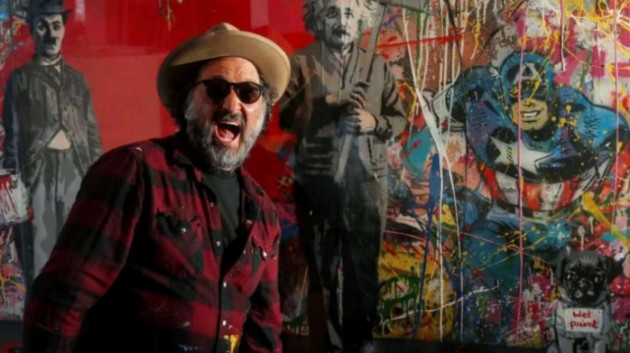
At the time of its release, there was a great deal of speculation in the press about whether or not the film was a hoax—or more precisely, since Life Is Beautiful really happened, if Guetta’s exhibition was a sincere effort or an elaborate prank he and Banksy orchestrated in order to expose the folly of the art world (see Felch). I suspect one reason people were dubious of the movie is that its plot has the neatness of fiction in which each event proceeds logically from the premises established at the beginning of the film. (Notice, for instance, how Guetta’s success in segment 31 seems plausible because the movie has already demonstrated in segment 3 that he has a knack for convincing rich idiots to overpay for crappy merchandise.) In other words, the film is simply too entertaining to be believed. However, it wouldn’t be as engaging as it is if not for its use of direct address, which unifies what would otherwise be a mass of disconnected images while arousing the viewer’s curiosity and directing one’s emotions. But while these are the most pervasive functions of direct address in documentary cinema, it can be employed more self-reflexively as well, as we shall see in the next segment of this essay.
Stories He Tells
Little Dieter Needs to Fly only came about because the German television station ZDF asked Herzog to contribute to their series Voyages to Hell. 3 According to Herzog:
The television executive actually wanted me to make a film about myself, all the stuff about landing in prison in Africa [during the making of Fata Morgana (1970)] and the problems on Fitzcarraldo [1982]. “This was difficult work,” I told him, “but they were not voyages to hell.” I vaguely remembered reading about Dieter in the 1960s, though by now he was very much forgotten. (quoted in Cronin, 265)
Dieter Dengler (1938-2001) was a German-born American navy pilot who was shot down over Laos during the early stages of the Vietnam War. After learning that their guards were planning to murder them, Dengler and six other POWs managed to escape by slipping out of their restraints while the guards were eating, though in the end, only Dengler and a Thai soldier, Pisidhi Indradrat, made it out of the jungle alive. But while Dengler addresses the camera directly in twenty-five of the movie’s thirty-seven segments, the documentary is much more than a filmed deposition. As in Exit Through the Gift Shop, direct address unifies large-scale segments and inflects the meaning of individual sequences of images while stimulating the viewer’s curiosity about Dengler’s past. At the same time, the obvious discrepancy between sound and image makes the spectator acutely aware that the movie is a representation of an inaccessible—and indeed, unfathomable—reality. However, rather than lessening the emotional impact of Dengler’s story, the film’s self-reflexive style encourages a different kind of involvement.
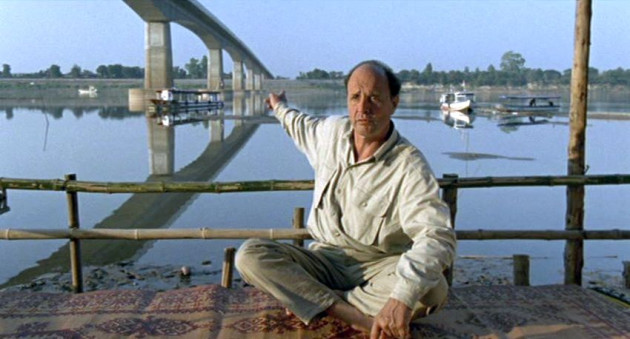
In the following segmentation, sequences labelled “T” employ printed titles; “VO:H” and “VO:D” designate segments featuring voice-over commentary, either by Herzog (H) or Dengler (D); segments marked “PC” incorporate archival footage of the press conference Dengler gave after his rescue in 1966; “DA” stands for direct address (i.e., Dengler speaking directly to the camera), and “Q” for questions Herzog asks Dengler while standing off camera:
1. Epigraph; Dengler describes his vision to a tattoo artist (T)
2. Opening credits; a haunted man (T, VO:H, VO:D)
I. The Man
3. Dengler’s obsessions with opening doors and storing food (T, DA, VO:H, PC)
4. Dengler’s parents and Dwayne Martin’s severed head (DA)
5. Archival footage of planes
II. His Dream
6. Dieter’s childhood memories and dream of flight (T, DA)
7. Archival footage of planes taking off from a carrier
8. Dengler’s war medals and photographs (DA, Q, VO:H)
9. Hunger in postwar Germany (VO:D, VO:H)
10. Dengler’s apprenticeship as a clockmaker (VO:H, DA)
11. Leaving Germany (VO:H, DA)
12. Arriving in America (VO:D, DA)
13. Flying over Laos (VO:H)
14. Shot down (DA)
15. Dengler talks about fear and jellyfish (DA)
III. Punishment
16. Capture; the airport dream; the first escape attempt (T, DA, VO:H, VO:D)
17. Caught (VO:H, DA)
18. Torture (VO:H, DA)
19. Dengler’s dissident grandfather (DA)
20. “Only a film” (DA, VO:H, VO:D)
21. Learning to survive in the jungle; the army training film (DA, VO:H, T)
22. A mobile barbecue (DA)
23. Dengler’s engagement ring (DA)
24. Arriving at the prison camp (DA)
25. Dreaming of oceans (VO:H, VO:D)
26. The food in the camp (DA)
27. Going to the bathroom (PC)
28. The route to Thailand (VO:H)
29. The escape plan (DA)
30. How to get out of handcuffs (VO:H, DA)
31. The escape (DA)
32. Into the jungle (VO:D, DA)
33. A river like this one; the waterfall (VO:H, VO:D, DA)
34. Martin’s death and the bear (VO:D, DA)
35. Life after war (VO:H)
IV. Redemption
36. How Eugene Deatrick rescued Dengler (T, VO:H)
37. Sneaking out of the hospital; a heaven for pilots (VO:H, DA, VO:D, T)
C. End credits
As can be seen from this segmentation, printed titles divide the movie into a prologue and four chapters with the chapter headings providing a unifying conceptual frame for each large-scale segment of the film. Beginning with a quote from the Book of Revelations printed on a black screen (“And in those days shall men… desire to die, and death shall flee from them”), the prologue and the first chapter establish that Dengler is a man still haunted by his experiences as a POW. The next chapter, “His Dream,” doubles back to recount Dengler’s early life, from his childhood in Germany during World War II up until the time of his capture in Laos, and as the title suggests, is unified by Dengler’s goal of flying. In the third and longest chapter, “Punishment,” Dengler forms a new goal—namely, to escape his captors and reach the Thai border—and the segment ends with his despair over the death of his friend and fellow soldier, Dwayne Martin. And in the final chapter, “Redemption,” another military pilot, Eugene Deatrick, relates how he came to rescue Dengler over Thanksgiving dinner, and the latter describes his subsequent recovery in a military hospital. The movie ends with a printed coda superimposed over a lengthy aerial shot of Dengler standing in a sort of graveyard for disused military planes, which he describes as a “heaven for pilots.” 4
At the level of individual segments, the film’s voice-over commentaries guide the viewer’s interpretation of specific sequences of images. In segment 2, over a shot of Dengler driving an antique car through a misty landscape, Herzog says in voice-over, “Men are often haunted. They seem to be completely normal but they are not,” and accordingly, the viewer interprets the shot of Dengler at the wheel as denoting, at least primarily, his apparent normalcy—rather than, say, his enthusiasm for driving or the poor visibility caused by the fog, which are both equally plausible inferences. What’s more, while the shots used in the following montage of archival images from the Vietnam War will be familiar to many viewers from earlier documentaries and fiction films—notably, Oliver Stone’s Nixon (1995), where they’re associated with the escalation of the US bombing campaign—here Dengler’s voice-over recodes the images so that, instead of signifying the suffering that US foreign policy inflicted on the civilian populations of Indochina (or the strategic effectiveness of the bombing), they stand in for the suffering Dengler personally caused the people of Laos.
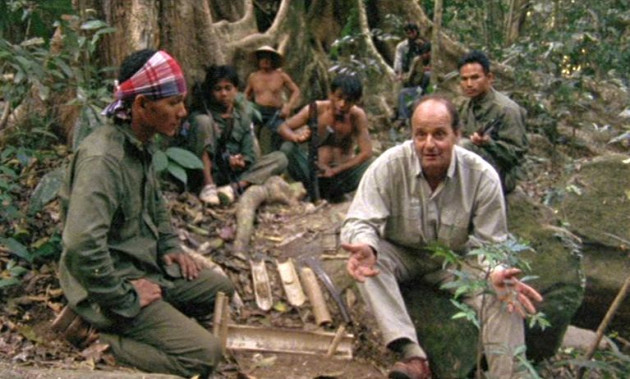
Voice-over commentary also helps to guide the viewer’s emotions in much the same manner as it does in Exit Through the Gift Shop. When we see clips from a military training film giving recruits whimsical advice on how to survive in the jungle (segment 21), it’s Herzog’s commentary that sets the bemused tone as it might not be apparent from the images themselves what advice the film is giving (Herzog doesn’t retain the original soundtrack) or why this advice was useless in the jungles of Laos. (Incidentally, had Herzog kept the original audio, it might’ve explained why the soldier in the film is seen desperately signaling to a helicopter just above his head—an image Herzog claims to find utterly baffling, though in fact it subtly foreshadows Dengler’s own rescue later in the documentary.) Herzog’s third-person voice-over also helps to establish a broader historical perspective on Dengler’s story, particularly in a sequence describing conditions in postwar Germany (segment 9), in which Herzog—who was born in Bavaria in 1942—seems to be telling his own story, and that of countless others, through Dengler’s.
In the film’s early sequences, the voice-over commentaries and Dengler’s onscreen testimony generate curiosity about his past by withholding certain facts from the viewer, either alluding to his experiences as a POW only generally or in very specific images presented entirely out of context, as when Dengler casually mentions Martin’s decapitation in segment 4—an event that isn’t properly explained until segment 34. Likewise, the opening epigraph and the scene in the tattoo parlour, in which Dengler describes hallucinating that Death didn’t want him, implicitly raise the question of what happened to him during the war that would not only make him want to die but to feel spurned by death’s refusal to come. This pattern can be observed within individual sequences as well. While describing how he came to rescue Dengler in segment 36, Deatrick recalls that he initially mistook him for a Laotian villager as he flew by overhead, and since the viewer already knows that Deatrick ultimately rescued him, one’s curiosity hinges on the question of what made him go back to take a second look.
Despite the multiplicity of discourses in the film (printed titles, voice-overs, the footage from Dengler’s press conference, and his informal dialogues with Deatrick and the tattoo artist), Dengler’s first-person testimony is the dominant around which the other voices are organized—something especially apparent in the third chapter, where he addresses the camera in fifteen of twenty segments. Accordingly, in contrast with Exit Through the Gift Shop, where direct address aids the viewer’s comprehension of the found images, here it’s the still photographs, drawings, and staged reenactments that aid one’s comprehension of Dengler’s monologue through their redundancy. In segment 23, while describing how a Viet Cong soldier cut off a Laotian villager’s finger for stealing Dengler’s engagement ring, Dengler holds a Thai actor by the wrist with one hand and manipulates his fingers with the other so that one of the actor’s fingers is sticking out. Then, still holding his wrist, Dengler makes a downward motion with his other hand as if holding an invisible machete handle before jumping back and putting up both his hands to suggest the spraying of blood. Similarly, as Dengler recounts his journey from the crash site to the POW camp (segments 20-23), reenacted shots of his captors marching him through the jungle with his hands tied behind his back provide transitions between the various scenes in which Dengler continues his story in different locations, as if he were literally retracing his steps as he related his experiences—despite the fact that Herzog had to shoot these scenes in Thailand because he couldn’t get permission to film in Laos (Cronin, 266).
That said, much critical commentary on the movie has centered on the lack of a precise fit between Dengler’s words and the images representing his experiences. As Stefanie Harris points out, Herzog’s use of still photographs to illustrate Dengler’s childhood memories undermines the photographs’ legitimacy as “viewers may become suspicious that the ‘moments’ captured… do not in fact correlate with those moments which they claim to depict” (138). In particular, when Dengler describes how he and his brothers stood at an attic window watching the American planes fly in to bomb their town, the film cuts to a black and white picture of two boys looking out a window even though Dengler mentions three boys (ibid.), and what’s more, it seems unlikely that his parents would think to take a family picture as the bombs were falling. Similarly, as we’ve already seen, the shots representing the suffering Dengler inflicted on the people of Laos are familiar stock images, and he couldn’t have seen the training film Herzog appropriates since, according to a superimposed title, it was made in 1967—that is, well after Dengler’s rescue on July 20, 1966.
Furthermore, as Bill Nichols writes, “the reenacted scenes in Little Dieter exhibit a Brechtian sense of distanciation. […] Neither Dieter nor Herzog seek to render suspense dramatically or verisimilitude perfectly. The necessary awareness of a gap between past event and present reenactment remains altogether vivid” (83). In other words, unlike Christian Bale’s Method performance in Herzog’s Rescue Dawn (2006), in which the actor attempts to incarnate the young Dieter, here Dengler stands somewhat apart from the reenactments he participates in while relating his experiences to the camera (Brecht, 20), thereby foregrounding the fact that both the reenactments and his oral testimony are representations of events which the viewer doesn’t have direct access to. But while Nichols is correct that the Thai actors’ “half-hearted good-natured [performances]… [conjure] what Dengler went through without compelling prisoner or guards to reenter the psychic and emotional space of the original events” (83), this doesn’t mean the viewer isn’t emotionally involved in Dengler’s story. On the contrary, one is involved in both the story itself and its telling. Accordingly, in contrast with Exit Through the Gift Shop, where the participants describe in interviews how they felt at the time, here Dengler’s voice-over and oral testimony emphasize the emotions he feels as he relates his experiences. In segment 20, as the Thai actors march Dengler through the jungle with his hands tied behind his back, Dengler describes in voice-over how reenacting this experience made his heart beat faster. Similarly, as he relates the circumstances of Martin’s death and the despair he felt afterwards in a lengthy monologue, Dengler becomes increasingly despondent until he seems to be choking back tears. And by switching to a more indirect mode of address in the scene with Eugene Deatrick, Herzog highlights the easy rapport between the two men, suggesting that, for Dengler, Deatrick’s friendship came to take the place of Martin’s.
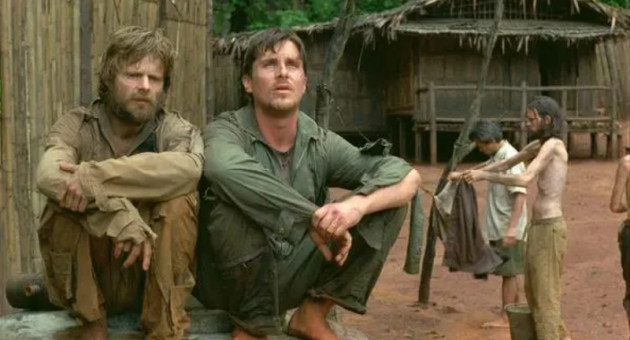
Rescue Dawn
Discussing the film in a 2002 interview, Herzog told Paul Cronin, “The German television network wanted me to film re-enactments of the events Dieter was talking about, the kind of stupid thing you can see on television worldwide. I hate this kind of stuff so much and thought it better that Dieter do it all himself” (277). However, given the fact that Herzog directed a fictionalized version of Dengler’s wartime experiences using professional actors just four years after this interview, it would appear that what he objected to weren’t representational reenactments per se but the marriage of this type of reenactment with direct address. In any case, a comparison of Little Dieter Needs to Fly with Rescue Dawn demonstrates that it’s sometimes more advantageous to narrate a story than to dramatize it—even one as rich in incident as Dengler’s. In addition to unifying large-scale segments, inflecting the meaning of individual sequences, and arousing the viewer’s curiosity, direct address places Dengler’s story in a broader social context, and the lack of a precise fit between his oral testimony and the images and reenactments representing his experiences self-reflexively foregrounds the film’s artifice. However, rather than weakening the viewer’s emotional involvement in the story, this self-reflexivity allows for a different kind of engagement that wouldn’t be possible in a straightforward representational account.
Conclusion
Although it sounds commonsensical, I contend that the dictum “show, don’t tell” has little practical value, either as criticism or as a rule of thumb for practicing filmmakers. If we see a documentary that engages us, we’re not likely to fault it for using a voice-over, nor will we be less bored by an uninteresting film that does without one. Indeed, while one can doubtlessly point to circumstances in which direct address is superfluous, detrimental, or simply lazy, there are just as many circumstances in which it’s beneficial, unifying what would otherwise be a disconnected series of images, stimulating the viewer’s curiosity, guiding one’s emotional responses, and self-reflexively foregrounding the materials a particular movie consists of. The challenge for filmmakers and critics is to be able to judge when a specific device is warranted and when it’s not, which requires more thought than simply regurgitating prescriptive maxims.
Bibliography
Bordwell, David. “Tell, Don’t Show.” Observations on Film Art, n.p., January 6, 2010. Web. Accessed October 25, 2016.
Brecht, Bertolt. “Theatre for Learning.” Trans. Edith Anderson. The Turlane Drama Review, 6:1, September, 1961. 18-25. Print.
Cronin, Paul. Herzog on Herzog. London: Faber, 2002. Print.
Felch, Jason. “Getting at the Truth of ‘Exit Through the Gift Shop’.” Los Angeles Times, February 22, 2011. Web. Accessed May 27, 2017.
Greenaway, Peter. “105 Years of Illustrated Text.” Francis Ford Coppola’s Zoetrope: All-Story, 5:1, Spring 2001. Web. Accessed November 24, 2016.
Harris, Stefanie. “Moving Stills: Herzog and Photography.” In A Companion to Werner Herzog. Ed. Brad Prager. Hoboken: Wiley-Blackwell, 2012. 127-148. Print.
Horak, Jan-Christopher. “Wildlife Documentaries: From Classical Forms to Reality TV.” Film History, 18:4, 2006. 459-475. Print.
Nichols, Bill. “Documentary Reenactment and the Fantasmatic Subject.” Critical Inquiry, 35:1, Autumn, 2008. 72-89. Print.
Nichols, Bill. Introduction to Documentary. 2nd ed. Bloomington: Indiana University Press, 2010. Print.
Ruoff, Jeffrey. “Conventions of Sound in Documentary.” Cinema Journal, 32:3, Spring, 1993. 24-40. Print.
Thompson, Kristin. Storytelling in the New Hollywood: Understanding Classical Narrative Technique. Cambridge: Harvard University Press, 1999. Print.
“Winged Migration (2003).” Box Office Mojo. N.p., n.d. Web. Accessed May 23, 2017.
Notes
- As Jeffrey Ruoff observes, many observational documentary filmmakers share the view pervasive in Hollywood that voice-over is “the last resort of the incompetent”: “When [Richard] Leacock and [Ed] Pincus taught documentary filmmaking at the Massachusetts Institute of Technology in the 1970s, voice-over was not considered an acceptable technique” (31). ↩
- On what Bill Nichols terms the reflexive mode of documentary, see Introduction to Documentary, 194-199. ↩
- Paul Cronin lists two versions of the film, which is also known as Flucht aus Laos: a 75-minute theatrical version and a 52-minute version for German and English television (323). As Herzog shot the movie simultaneously in English and German (ibid., 265), this means there could be as many as four different versions of the film in existence. This analysis is based upon the 75-minute English language version. ↩
- Again, we can apply Thompson’s model to this film: a set-up lasting approximately 24 minutes and 30 seconds (segments 1-15), a development lasting 36 minutes (segments 16-35), a 6-minute climax (segment 36), and an epilogue that runs another 6 minutes (segment 37). ↩



